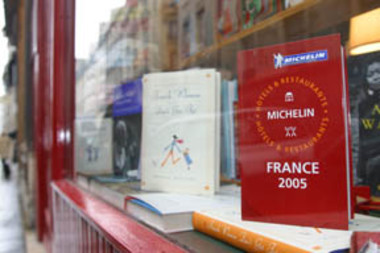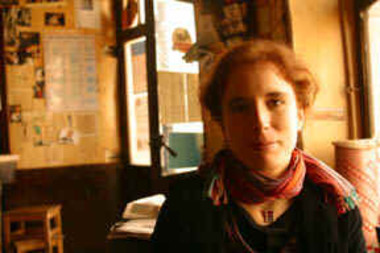Michelin to review Big Apple
May 4, 2005 - The Miami Herald

Perhaps the Michelin Red Guide is looking for greener pastures. Or maybe just something new to chew on.
After three straight years of less-than-flattering press in Europe, particularly in the Red Guide’s home country of France, the French gastronome’s restaurant Bible is now inviting itself to dinner in New York. Starting in November, the guide will become an arbiter of where to dine and stay in the Big Apple.
In its home country, the 100-year-old Red Guide does an impressive job among foodies of maintaining a buzz of who’s in, who’s out, who got a rating they didn’t deserve, who got stiffed and who’s on the outs.
A few years ago, however, Michelin’s press started to get ugly and every time it looks like things are settling down, something new happens that raises the question of whether or not it’s a good time to make the hop across The Pond.
The media slide began in early 2003 when famous French chef Bernard Loiseau committed suicide just after the French daily Le Figaro reported on rumors that his Burgundy restaurant, La Cote d’Or, was on the verge of losing its vaunted third Michelin star.
Though critics soon learned that Loiseau had many more problems than his standing in a guidebook, the affair had a larger effect on Michelin and ended up calling the guide’s honesty and objectivity into question.
PLAYING FAVORITES?
Last year the Red Guide’s credibility again was called into question—thanks to the book, L’Inspecteur se met Table (The Inspector Sits at the Table or The Inspector Spills the Beans), which was written by ex-Michelin inspector Pascal Remy. The critic alleged the guide plays favorites, doesn’t visit its rated restaurants as much as it says it does and is generally less on the up and up with its readers than readers believe.
Next, Michelin released its Benelux edition in January, giving a very favorable rating to a Belgian restaurant, the Ostend Queen, that had the curious distinction of not yet being open for business by the time the guide came out. After the Brussels daily, Le Soir, picked up on the gaffe, the rest of the media had a field day and Michelin was forced to recall all that remained of the 50,000 copies on bookstore shelves.
The guide’s March 2 release in France went relatively well. Outside of the rise and fall of restaurants and the accompanying hullabaloo, the big news this year was the addition of a ‘‘rising star’’ category for restaurants on the brink of graduating to the next level.
TOP CHEF SPEAKS UP
Two days later, however, France’s top chef, Jol Robuchon, weighed in on a television interview, delivering a flurry of stinging jabs to the Michelin Man.
‘‘Today after all these mix-ups, it saddens me that we are beginning to question the impartiality of its judgment,’’ he said, before tearing into the ‘‘rising star’’ category as a ‘‘marketing coup’’ that would “put certain restaurateurs into purgatory.’’
 Parisian Anne Bory will be moving to New York for work on her PhD this fall. Even on a limited budget, Bory keeps tabs on Michelin’s starred restaurants in France and will be keeping an eye on what they do in New York. Photo by Joe Ray
Parisian Anne Bory will be moving to New York for work on her PhD this fall. Even on a limited budget, Bory keeps tabs on Michelin’s starred restaurants in France and will be keeping an eye on what they do in New York. Photo by Joe RayDespite all the bad press, Michelin is, was and will continue to be the restaurant référence for one million French and other Europeans who buy the guides every year. In France, nobody comes close to the stature the Michelin Red Guide holds: the French edition of 2004, for example, sold 415,000 copies in France, obliterating the 70,000 copies sold by the nearest competitor, GaultMillau.
This is part of the reason why Michelin is not only pushing ahead with the New York guide but also planning on following up with editions covering other major U.S. cities.
‘’[The bad press] has no effect on going into New York,’’ says Michelin spokeswoman Marie-Benedicte Chevet, who says the company expects to print between 80,000 and 400,000 copies of the new guide. “We’ve been thinking about putting the guide together for a long time now and New York is becoming a haut lieu gastronomique [a place of refined cuisine].’‘
The idea of a New York guide from a French publisher (the New York inspectors are both American and European) makes more sense if one considers the Michelin Red Guide is the brand Europeans coming to New York will recognize long before they figure out what Zagat is.
Michelin is betting a good chunk of the 40-million hungry visitors who come to the Big Apple every year will choose the New York version of the Red Guide.
‘‘Will I buy the New York version? Absolutely,’’ says Hervé Mathieu, founder of Fragrance Forward perfumes. Mathieu, who visits New York on business about twice a year, continues to use Michelin as a reference and already knows about the November release of the Big Apple guide.
COMMON IN FRANCE
‘‘In France you don’t need to ask people if they have one, they just have one,’’ he says. “I think for French and Europeans who are looking to eat well in the U.S.—and that can be a problem—they can naturally turn toward Michelin.
‘‘You’re used to the architecture of their guides; you know how they work. If it works for us here, it will work there as well,’’ he says.
Parisian Anne Bory will be doing field work for her sociology Ph.D. at Columbia University in New York this fall. Even on a limited budget, Bory keeps tabs on Michelin’s starred restaurants in France and will be keeping an eye on the New York ratings.
‘‘If I saw [the New York] version in a bookstore, I’d definitely check it out to see if I recognized any place,’’ she says. “I don’t think it’s aimed directly at me, but I’d imagine it would work well for people who were coming to work in the city for a while or high-end tourists.’‘
FORGIVING READER
As for the guide’s recent media troubles, Mathieu is rather forgiving.
‘‘A perfect guide is rather angelic, but not very realistic,’’ he says. “Sure, there’s probably some fishy stuff going on, but its within the margin of human error.’‘
Joe Ray is a freelance writer living in Paris. He can be reached via his website at www.joe-ray.com.